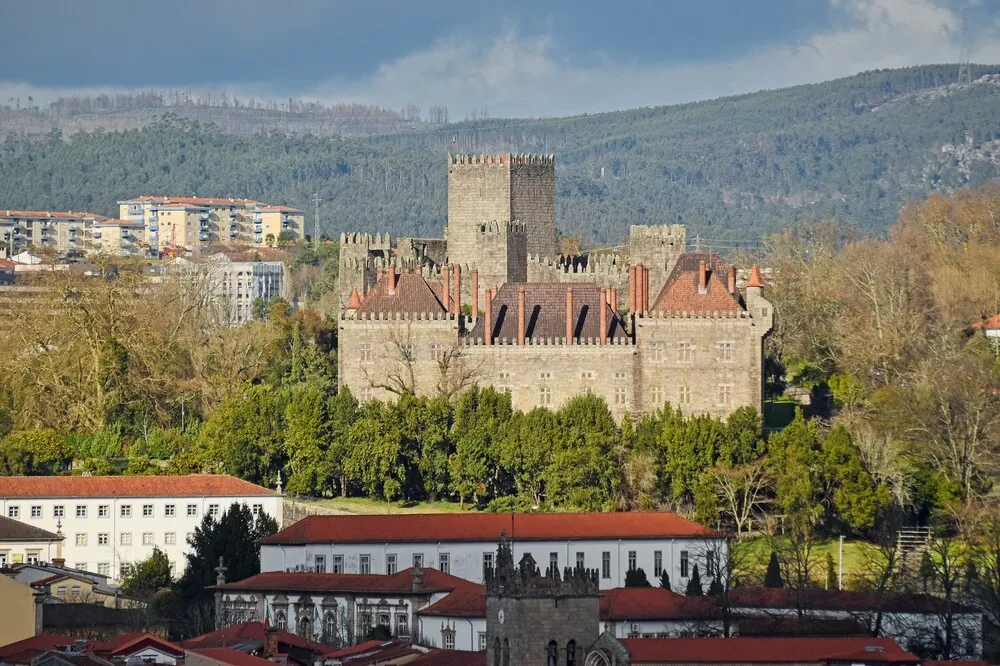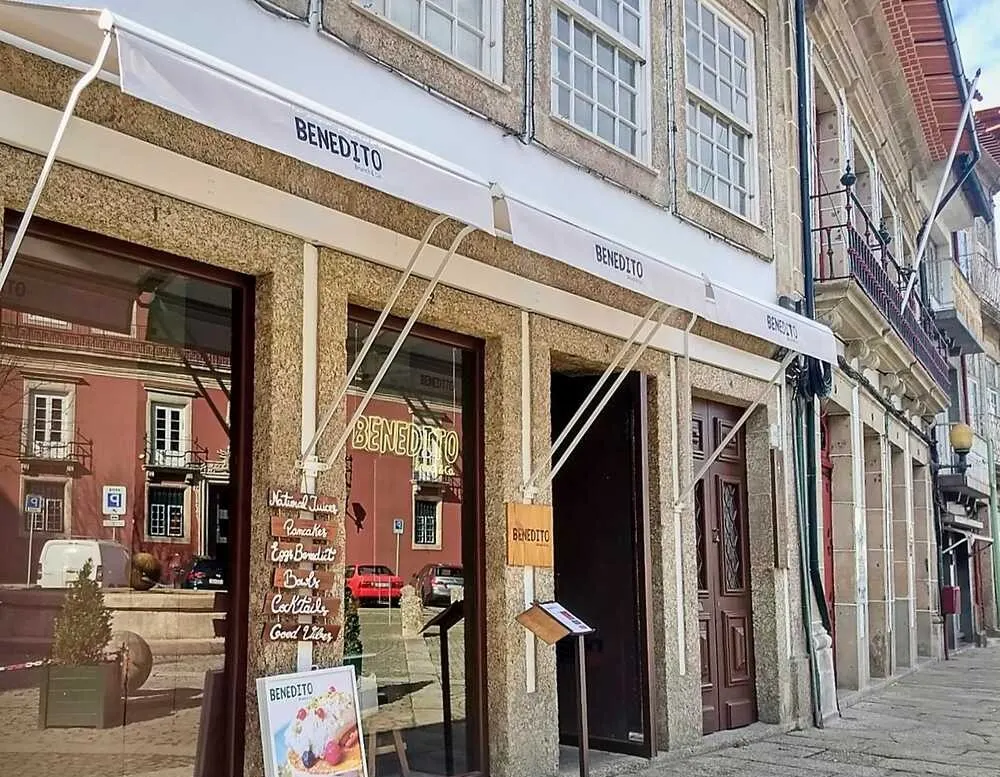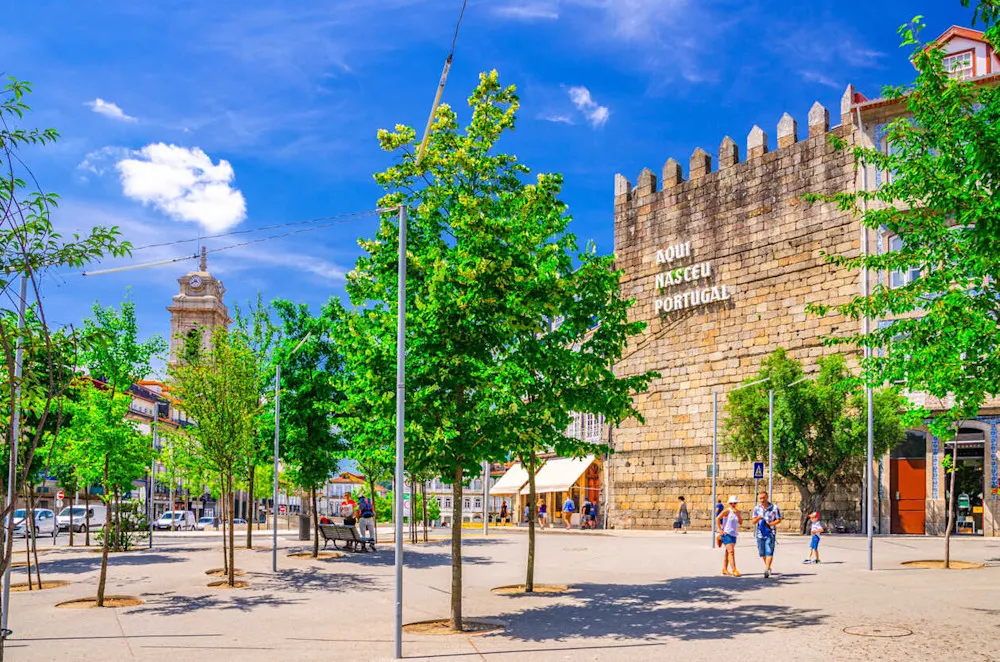Strolling the medieval streets of this UNESCO World Heritage Site—a former Roman city and the birthplace of Portugal’s first king—it’s impossible not to be captivated.
As the historical capital of the Minho province, Guimarães is rich in architectural splendor—from the imposing 10th-century castle to the distinctive red-brick chimneys of the 15th-century palace built by the first Duke of Bragança.
This is a city of Gothic arches, grand churches and convents, and charming, photogenic streets like Rua de Santa Maria. You’ll find open spaces like Largo República do Brasil, a graceful stretch of manicured lawns and colorful flowers, anchored by a stately fountain and the Igreja da Consolação e dos Santos Passos, which dates back to 1785.
One popular gathering spot is Largo da Oliveira, where a majestic olive tree presides over a square filled with benches, locals, and visitors alike. University students mingle with old-timers who’ve lived on the same cobbled streets their entire lives.
It’s all undeniably enchanting—but is it a place you could ever truly call home?
Get Your Free Portugal Report Today!
Get Your Free Portugal Report Today!
Discover why we love healthcare in Portugal and in other European countries in our daily postcard e-letter. Simply enter your email address below and we’ll send you a FREE REPORT – Explore the Old World in Laidback Portugal.

By submitting your email address, you will receive a free subscription to IL Postcards and special offers from International Living and our affiliates. You can unsubscribe at any time, and we encourage you to read more about our Privacy Policy.
Lifestyle and Culture

With a population of about 52,000, Guimarães is home to several industries, including textiles, manufacturing, and tourism. Some local companies are open to hiring expats, particularly those with skills in engineering, management, or hospitality—a growing sector thanks to the region’s booming tourism. Teaching English is another viable option. So, if you’re looking for work, there are opportunities here.
If you’re relocating with children, public primary schools like Escola Básica 2,3 de Guimarães are well-regarded (though classes are taught in Portuguese). There’s also the International School of Guimarães, which offers English-language instruction. While locals often enjoy practicing their English, learning at least conversational Portuguese is both practical and respectful. The government even offers free language classes to foreigners through local high schools.
For higher education, Guimarães is home to a campus of the University of Minho, one of Portugal’s top universities, which offers a range of courses in English.
If your plan is simply to enjoy a relaxed retirement, the lifestyle options are endless.
You might take traditional pottery classes at Atelier Retiro, run by Indiana immigrant Joy Hanford, who says:
“Guimarães is a beautiful city. I pinch myself that I actually live here. The people are so friendly, and there’s so much to see and do—so many places to visit, and cake and castles to sample. It’s a very popular tourist day trip from Porto, so in the summer months, you can hear every language spoken on the streets.”
Attend a classical music concert or a jazz festival. Look out for the Festa da Flor, a vibrant springtime celebration filled with thousands of blooms, or the Feira Afonsina, a lively medieval fair held each June.
How might you spend a typical day in Guimarães? Start with breakfast at a sidewalk café, then browse hôma—a cheerful home store inside Guimarães Shopping mall. When we visited, the mall was celebrating its 30th anniversary with slices of sheet cake handed out to patrons (in true Portuguese style, it was a three-day celebration). A local radio station broadcast from a nearby table while, across the way, a woman stood inside a clear booth, trying to grab as much paper money as she could as it swirled around her—a scene straight out of Supermarket Sweep.
After shopping and people-watching, head upstairs to the food court for lunch and indulge in a French pastry before catching a movie. Films here are typically shown in their original language with Portuguese subtitles, so you’ll have no trouble understanding.
On another day, you might return to that pottery class, hop a train to Porto for sightseeing and wine tasting, or take a river cruise on the Douro. Maybe you’d rather just bring a book to a quiet café—where no one will rush you or bring the bill until you’re ready to leave—or sit in a park before stopping to pick up groceries for dinner. Shop owners, waitstaff, and restaurateurs here are used to visitors and are wonderfully friendly, so language barriers are rarely a problem.
Other shopping options include Espaço Guimarães and Centro Comercial São Francisco. For fresh produce, fish, and local crafts, check out the weekly market held every Friday behind the castle. On Saturdays, visit the Alberto Sampaio Museum, where vendors sell organic products, handmade jams, and liqueurs from 10 a.m. to 1 p.m. And on the first Saturday of each month, a flea market offers everything from gently used toys and books to jewelry, artwork, and clothing.
While you’re out and about, you’re likely to meet fellow expats—and you can also connect through platforms like Meetup and Facebook. And don’t forget: Porto, with its sizable expat communities and broader social scene, is just 35 miles away.
Transportation and Infrastructure
Getting around Guimarães is easy—except in the historic city center during peak tourist season. Keep in mind that the old town has vehicle access restrictions year-round, which helps preserve its charm. Fortunately, multiple underground parking structures are located just steps from shops and restaurants.
Elsewhere in the city, day-to-day outings are simple. Guimarães is compact and very walkable, though a bit hilly in places. Unless you have mobility concerns, it’s ideal for exploring on foot. Both taxis and Uber are readily available.
Public transport is reliable and affordable. Maria from Hotel Fundador shared that the local “Guimabus” service originates conveniently from the Guimarães Shopping parking lot. The network includes 66 lines, and the monthly pass is a bargain:
Regular adult fare: €17.15 ($18.60)
Retirees: €14.35 ($15.50)
Seniors 65+: just €8.60 ($9.50)
Buses can take you to nearby cities like Braga and Porto, or farther afield (sometimes combined with a train journey) to France or Spain. Trains are also an excellent option, whether you’re headed to Porto, Lisbon, the Algarve, or destinations outside Portugal.
For a different kind of ride, hop aboard the Teleférico—a scenic cable car that whisks you up Santa Catarina Mountain to the Sanctuary of Penha. This lush green area is perfect for hiking, biking, or simply soaking in the spectacular panoramic views of the city below.
Cuisine

Regional cuisine of the Minho includes Caldo Verde soup, Caldo River cabbage and bean stew, codfish fritters, pork loin, octopus, and beef and seafood dishes. After speaking with Pedro and João at the front desk of Hotel Fundador, we found Café Restaurante Transmontano, a block away and opposite the train station. The staff was very accommodating, even making a meatless, cheese-only omelet at my request. The fine restaurant at Hotel de Guimarães, Dona Maria—about a one-minute walk from the Hotel Fundador—was less traditional and fairly elegant, but quite affordable.
Overall, there’s a good variety available in town: pizza, pasta, sushi, Indian, and vegan. Café Milenário, founded in 1953 when Guimarães celebrated its 1,000th anniversary (hence the name), is a classic café, located next to the wall proudly proclaiming Aqui Nasceu Portugal—Here Portugal Was Born. We ducked in to escape a downpour and were greeted like long-lost regulars.
New places continue to pop up. Inês, an artist at Atelier Retiro clay studio, told me that two more restaurants recently opened. Budget permitting, you might drop into A Cozinha Por António Loureiro or 34, both Michelin-starred restaurants in the historic district.
Get Your Free Portugal Report Today!
Get Your Free Portugal Report Today!
Discover why we love healthcare in Portugal and in other European countries in our daily postcard e-letter. Simply enter your email address below and we’ll send you a FREE REPORT – Explore the Old World in Laidback Portugal.

By submitting your email address, you will receive a free subscription to IL Postcards and special offers from International Living and our affiliates. You can unsubscribe at any time, and we encourage you to read more about our Privacy Policy.
Climate and Healthcare

In Guimarães, you’ll experience a relatively mild climate year-round. Springtime (March through May) brings temperatures ranging from 50 F to 68 F. During the summer months of June, July, and August, expect warm, dry, and mostly clear days with temps between 75 F and 82 F. Autumn begins to bring some serious rain and cooler days and nights, which continue through winter (mid-November to early March), when it’s 40 F to 60 F and partly cloudy or wet.
According to the Euro Health Consumer Index, Portugal ranks 12th in Europe for its healthcare system—above countries like Italy and Belgium. If you’re a resident in Portugal, you can access the Serviço Nacional de Saúde (SNS), meaning you can tap into a wide range of health services for low fees or even for free.
Guimarães boasts several healthcare facilities, including two public and one private hospital, along with clinics where you can get everything from routine check-ups to specialized treatments. Public options are budget-friendly and of good quality, while private care is fast, efficient, and still won’t break the bank.
Cost of Living and Housing

Other than housing and dining out, most monthly expenses across Portugal are roughly the same.
Utilities for a couple in a two-bedroom apartment—including cell phones and internet—run about €200 ($217), and a typical monthly grocery bill for two might be around €500 ($542), depending on how often you eat out. Buying fresh produce directly from a farmers’ market can save a few extra euros.
As for dining out, a meal at a mid-range restaurant costs around €15–€20 ($16–22). For less, you can easily make a meal out of a burger or the famous Francesinha sandwich, created in Porto, or opt for a lunchtime prato do dia: soup, main course, dessert, and beverage for €8–€13 ($9–$14).
House cleaners receive about €10 ($11) an hour, and fuel currently costs $6.60/gallon. Plan on mass transit costing €10–€30 ($11–$33) a month.
Many familiar upscale clothing brands are available in malls and boutiques, but MO, often found in or near a Continente supermarket, has prices comparable to Ross Dress for Less or T.J. Maxx.
Rentals in Lisbon can be almost twice as much—and in Porto, 30% higher—than those in Guimarães. For example, a one-bedroom condo in Lisbon’s popular Parque das Nações neighborhood sells for €445,000 ($482,600), and a one-bedroom rental in that same location costs €1,200 ($1,300). Compare that with Porto’s Lomba, Bonfim neighborhood: €270,000 ($293,000) to buy and (surprisingly) also €1,200 ($1,300) for a one-bedroom rental.
In Guimarães, listings show a one-bedroom available to buy for €215,000 ($233,000), a two-bedroom for €230,000 ($249,000), and three-bedrooms ranging from €247,000–€260,000 ($268,000–$282,000). Rentals are equally appealing: a new one-bedroom near the hospital is €850 ($922), and a two-bedroom in the city center goes for €950 ($1,030). Naturally, if you live outside the city center, you may find even more affordable options.
Final Verdict: Ready Now
Guimarães is an international city, but less expensive than Lisbon or Porto. And there’s a pervasive sense of calm, even in the city center. We walked home from it to our hotel at 10 p.m. one night and felt perfectly safe. All we encountered was a group of young people, instruments in hand, on the sidewalk outside a church after music practice. My husband mounted the stairs to peer inside the windows, and although they were locking the doors, they reopened and invited us in for a look around.
That small-town attitude is another reason I’d choose it over either of the above cities—or even over Braga, another notable city in the north. While a city may be equally safe, that doesn’t necessarily equate to peaceful or, frankly, to friendly. I found the traffic, convoluted streets, and the stress of locals disconcerting when we were last in Braga.
If some days you feel the need for even more tranquility than the town of Guimarães offers, you need only head an hour north to Peneda-Gerês National Park, along the Spanish border. Lush forests, waterfalls, valleys, pristine rivers, and Roman ruins lure hikers and campers, as well as those who opt to stay a while in comfortable lodging.
In sum, Guimarães expats say it offers them a relaxed lifestyle, affordable living, and a rich culture. I agree.

Get Your Free Portugal Report Today!
Get Your Free Portugal Report Today!
Discover why we love healthcare in Portugal and in other European countries in our daily postcard e-letter. Simply enter your email address below and we’ll send you a FREE REPORT – Explore the Old World in Laidback Portugal.

By submitting your email address, you will receive a free subscription to IL Postcards and special offers from International Living and our affiliates. You can unsubscribe at any time, and we encourage you to read more about our Privacy Policy.












